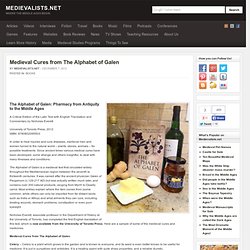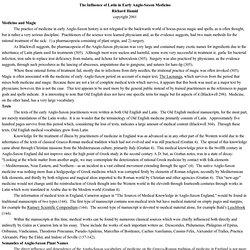

Medieval Medical Malpractice. Digital Repository of Documents: Record#25286: Books as a source of medical education for women in the middle ages. Books as a source of medical education for women in the middle ages Green, Monica H. Date: 2000 Abstract: The development of philosophical medicine in the high and late Middle Ages brought with it a powerful association of medical knowledge with the written word. To possess books, or at least to have access to books, was both a prerequisite for and a symbol of the kind of theoretical learning that distinguished the learned practitioner from the empiric.
This study examines evidence for women’s access to medical books, raising the question of what difference gender made. What's Wrong with Early Medieval Medicine? Melancholia-ae. The religious experience of the "disease of the soul" and its definitions in the early modern period: censorship, dissent and self-representation The seminar aims at exploring the different meanings of the term "melancholy" in early modern religion, both Protestant and Catholic.

One of its main purposes will be to enquire into, clarify, and emphasize both elements of continuity and what was specific to each of the diverse discourses on melancholy within the historical, socio-cultural, political, geographical and linguistic contexts that framed its production. In its various historic-artistic, medical, literary, philosophical and psychological manifestations, melancholy has been the subject of a vast literature. Moreover, ‘melancholy’ – the word itself – is a polysemic term historically associated with a large variety of groups of distinct meanings. In particular, it underwent a sort of semantic expansion between the 16th and 17th century.
Submissions Languages: Italian, English, French. Medieval Cures from The Alphabet of Galen. The Alphabet of Galen: Pharmacy from Antiquity to the Middle Ages A Critical Edition of the Latin Text with English Translation and Commentary by Nicholas Everett University of Toronto Press, 2012 ISBN: 9780802095503 In order to heal injuries and cure diseases, medieval men and women turned to the natural world – plants, stones, animals – for possible treatments.

Since ancient times various medical cures have been developed, some strange and others insightful, to deal with many illnesses and conditions. Break a Leg! Fracture Treatment in Iron Age and Roman Britain « Bones Don't Lie. Medical treatment, despite our own Western perspective of science, is a cultural trait.

How we choose to treat different forms of trauma, the methods of recovery, and the beliefs surrounding medicine are all culturally dictated. In our own society there are constant debates over the necessity to get certain vaccinations, whether one should be active or in bed during certain sicknesses, the actual efficacy of chicken noodle soup, or if the entire thing could be healed simply by being less ‘stressed’. We rely on science and popular belief, which change drastically over time.
There have long been debates over the changes that occurred in health with Romanization. Examination of skeletal remains have shown both improvement and decline in overall health. Ancient Roman Medical Tools, via Flickr user vignish2011 Redfern (2010) examined 270 sexed adults and 190 subadult individuals for evidence of ante mortem fractures and surgical practice in Dorset. Works Cited Redfern, Rebecca (2010). « Che manza fichi, semina rogna » : problèmes d'identification d'une dermatose au Moyen Age - M. Nicoud.
Remèdes et soins aux malades dans les monastères alsaciensdu Moyen-âge (VIIIe au XIIe siècles) - P. Bachoffner. Early medieval Latin adaptations of Byzantine medicine in western Europe - G. Baader. Recherches sur le crime de poison au Moyen Âge - F. Collard. Espaces et pratiques du bain au Moyen Age - D. Boisseuil. Dormir au Moyen Age - J. Verdon. Thérapeutiques oculaires au Moyen Age - P. Delaveau, J. Barbaud. La peste dans le haut Moyen Age - J. Le Goff, J.N. Biraben. Comment on traitait la paralysie au haut Moyen Age - P.A. Sigal. Magic and Medicine in Anglo-Saxon England. The Influence of Latin in Early Anglo-Saxon Medicine Richard Hamid copyright 2001 Medicine and Magic The practice of medicine in early Anglo-Saxon history is not relegated to the backwards world of hocus-pocus magic and spells, as is often thought, but is rather a very serious discipline.

Practitioners of the science were learned physicians and, as the evidence suggests, had two main methods for the rational treatment of the sick: 1) a pharmacopoeia consisting of plant origin, and 2) surgery. As Blackwell suggests, the pharmacopoeia of the Anglo-Saxon physician was very large and contained many exotic names for ingredients due to the inheritance of Latin plants used for treatments (305). Where these rational forms of treatment fail, mostly due to infections from dirty needles, the irrational practice of magic was often invoked (305). Texts The texts of the early Anglo-Saxon practitioners were written in both Old English and Latin. English A.S. Beet bete beta chestnut cisten beam castanea. L’animal et la pensée médicale dans les textes du Haut Moyen Age.